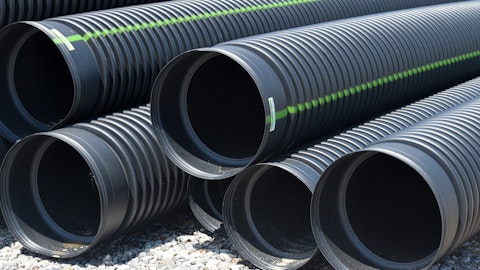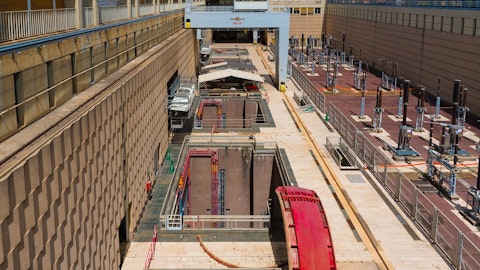We’re going to keep some of the price, but we’re also going to give back some.” And again, PVC we talk about because that’s the biggest product from the price up. But you have those dynamics across all the other products, which by the way, some products I won’t call off specifically, we see giving up some price, other ones probably the strongest price either ever or at least in the last year or two. And we just put price increases out on, I guess, I can share, on metal conduit yesterday here. As steel costs go up, we’re raising our metal conduit prices. So, I don’t want to say business as usual because it’s a headwind, but it’s very much playing out like we estimate it this time.
David Johnson: And Deane, remember, we always said that the volume in the PVC business, obviously, has the component of what drives some pricing element. And in Q4, our PVC volumes were flat year-over-year, which was certainly better. We were trending better throughout the year, but we started pretty significantly down here every year. So, I think that’s a positive. Going into Q1, we have seasonality. That business probably has more seasonality than anybody given that it does go into the ground, so on and so forth. So I think, as Bill mentioned, pretty much in-line, maybe slightly better than what we expected.
Bill Waltz: And the other thing, Deane, not part of your question, but what I’m excited about that shareholders should be is the chart that we walked through where we’re forecasting double-digit organic growth, which to me was that and the dividend were two things that should be very positively received by our shareholders as we go forward. That’s the two things. In fairness, de-stocking happened last year, so we don’t have that happening again in the market. And then, the fact that we are the [self-help] (ph) of all these different initiatives are starting to pay off here. So that’s really when we make the statement about we’re excited about the future of Atkore, these are some of the reasons for that.
Deane Dray: That’s all good to hear, and that’s great color. I mean, just a quick clarification on Alex’s question regarding volume. If we were looking for mid-single-digit volume this quarter, you came in low single, how much of that, if you were to size the shortfall there, was the timing of the government stimulus and the telecom choppiness there? Is that — does that account for all of it?
Bill Waltz: Do you want to go, David?
David Johnson: Yeah, I can. I would say maybe half to maybe a little bit more than half was due to the HDPE environment. And then, the other portion would be our slower-than-anticipated startup for our solar plant.
Deane Dray: Good. Okay. So that’s…
David Johnson: One of the two within our control, and the other one, as we mentioned, is probably in our market that’s going to take a little bit to get back to where we expect it to be.
Deane Dray: All right. That clarification is helpful. And then just last question for me is on cash flow, was seasonally for your fiscal fourth quarter a bit light. Just kind of take us through the dynamics there. And I also just want to give a shout out, great to see you initiate the dividend.
David Johnson: All right, thank you very much. Overall for the full year, our operating cash flow is actually above last year even though we were $300 million of EBITDA below last year, so I think that was very positive. The timing cue for this year again relates to the startup of [Technical Difficulty] in Indiana where it’s a little bit slower than we expected. So, we have the steel ready to go. So, we had a little bit higher elevated inventory levels, probably in solar. And I would argue the same — it’s the same in HDPE.
Deane Dray: Yeah, that clarifies. Thank you.
Bill Waltz: You’re welcome. Thanks, Deane.
Operator: Your next question comes from the line of Andy Kaplowitz from Citigroup. Please go ahead. Your line is open.
Andy Kaplowitz: Hey, good morning, everyone.
Bill Waltz: Hey, good morning, Andy.
Andy Kaplowitz: Bill, maybe just a little more color into your markets. Just inventory of your products, I mean, I think you’ve talked about it being reasonably low in PVC and metal conduit, as it’s still the case. Are you seeing any impact on larger projects, either non-res or res from the higher rates? I know you talked about stimulus and HDPE, but anything sort of more macro that you could talk about? And I think last quarter you mentioned you were having a strong July. Did you see any change in the cadence of your businesses as you went through Q4 and now here into Q1?
Bill Waltz: Yeah. So, I’ll start and then David may have to help me. It feels like years ago for the last quarter. But, Deane — or Andy, maybe I’ll go with different direction though. The large projects overall are really strong. I would even say if you look at any macro indicator, ABI, Dodge and so forth, the amount of large projects that are starting with some of the stimulus to go, whether it’s new factories going up, whether chips, data centers being driven by artificial intelligence, and that’s just in the United States, [indiscernible] again, we do have a global presence here, really drives some of the optimism that we had with the forecast for double-digit growth. So, overall, we’re optimistic on the markets going forward especially with these large projects that we’re involved in. And then, I don’t recall anything specifically, say, July versus August.
David Johnson: No, I don’t think, it’s a pretty consistent. But I would also say, Andy, the other thing that we’re really encouraged about is other players in our industry have announced quite a bit of capital investment, not for our products, but for other products that we would argue is slowing down just the volumes in the whole industry. But the fact that they’re investing hundreds of millions of dollars in capacity in the U.S. to help expand the electrical capacity, I think that’s a very big positive for us.



